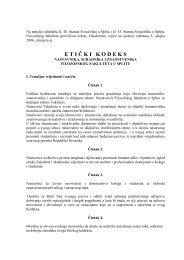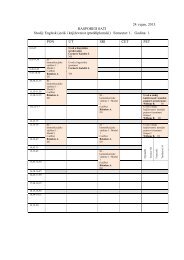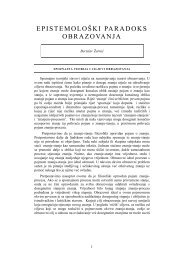Understanding Human Communication
Understanding Human Communication
Understanding Human Communication
You also want an ePaper? Increase the reach of your titles
YUMPU automatically turns print PDFs into web optimized ePapers that Google loves.
320 PART THREE COMMUNICATION IN GROUPS<br />
this chapter for building group cohesiveness and encouraging<br />
participation.<br />
Many naive observers of groups confuse the concepts<br />
of leader and leadership.We defined leadership<br />
as the ability to influence the behavior of other members<br />
through the use of one or more types of<br />
power—legitimate, coercive, reward, expert, information,<br />
or referent.We saw that many nominal leaders<br />
share their power with other members.Leadership has<br />
been examined from many perspectives—trait analysis,<br />
leadership style, and situational variables.<br />
Smart members will avoid some common dangers<br />
that threaten a group’s effectiveness.They will make<br />
sure to get the information they need, without succumbing<br />
to overload.They will make sure that participation<br />
is equal by encouraging the contributions of<br />
quiet members and keeping more talkative people on<br />
track.They will guard against groupthink by minimizing<br />
pressure on members to conform for the sake of harmony<br />
or approval.<br />
KEY TERMS<br />
authoritarian leadership<br />
style 312<br />
brainstorming 301<br />
buzz group 294<br />
coercive power 309<br />
cohesiveness 305<br />
conflict stage 304<br />
democratic leadership<br />
style 312<br />
emergence stage 304<br />
expert power 310<br />
focus group 294<br />
force field analysis 300<br />
forum 295<br />
groupthink 318<br />
information<br />
overload 316<br />
information power 310<br />
information<br />
underload 316<br />
laissez-faire leadership<br />
style 312<br />
leader 308<br />
Leadership Grid 314<br />
legitimate power 308<br />
nominal group technique<br />
301<br />
nominal leader 308<br />
orientation stage 303<br />
panel discussion 295<br />
parliamentary<br />
procedure 294<br />
participative decision<br />
making 292<br />
power 308<br />
probative question 299<br />
problem census 294<br />
referent power 310<br />
reinforcement stage 304<br />
reward power 309<br />
situational<br />
leadership 315<br />
symposium 295<br />
trait theories of leadership<br />
312<br />
ACTIVITIES<br />
1. When to Use Group Problem Solving Explain<br />
which of the following tasks would best be managed<br />
by a group:<br />
1. Collecting and editing a list of films illustrating<br />
communication principles.<br />
2. Deciding what the group will eat for lunch at a<br />
one-day meeting.<br />
3. Choosing the topic for a class project.<br />
4. Finding which of six companies had the lowest<br />
auto insurance rates.<br />
5. Designing a survey to measure community attitudes<br />
toward a subsidy for local artists.<br />
2. Increasing Group Creativity You can increase<br />
your skill at increasing creativity in group discussions<br />
by trying the approaches described in <strong>Understanding</strong><br />
<strong>Human</strong> <strong>Communication</strong>. Your group<br />
should begin by choosing one of the following problems:<br />
1. How can out-of-pocket student expenses (e.g.,<br />
books, transportation) be decreased?<br />
2. How can the textbook you are using in this (or<br />
any other) class be improved?<br />
3. How could your class group (legally) earn the<br />
greatest amount of money between now and<br />
the end of the term?<br />
4. What strategies can be used effectively when<br />
confronted with employer discrimination or harassment?<br />
(Assume you want to keep the job.)<br />
5. Imagine that your group has been hired to develop<br />
a way of improving the course registration<br />
system at your institution.What three recommendations<br />
will be most effective?<br />
Choose either brainstorming or the nominal group<br />
technique to develop possible solutions to your<br />
chosen problem. Explain why you chose the<br />
method. Under what conditions would the other<br />
method be more appropriate?<br />
3. Stages in Group Development Identify a problem-solving<br />
group, either from your personal experience<br />
or from a book or film. Analyze the group’s<br />
approach to problem solving. Does it follow the<br />
cyclical model pictured in Figure 9–1? Does it follow<br />
a more linear approach? Or does the group follow<br />
no recognizable pattern at all?

















